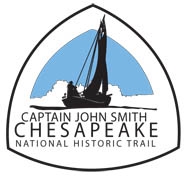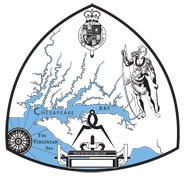

Come on a journey to remember and commemorate the history and travels of Captain John Smith!
Over four hundred years ago, Englishman John Smith and a small crew set out in an open boat to explore the Chesapeake Bay. Between 1607 and 1609 Smith mapped and documented nearly 3,000 miles of the Bay and its rivers. Along the way he visited many thriving American Indians communities and gathered information about this “fruitful and delightsome land.” In December 2006 the U.S. Congress designated the routes of Smith’s explorations of the Chesapeake as a national historic trail—the first national water trail.
Are you ready to follow in the wake of Captain John Smith? Visit sites along the National Historic Trail and learn about the native cultures and the natural environment of the 17th-century Chesapeake through the Captain John Smith Chesapeake Geotrail. The Trail provides opportunities for you to experience the Bay through the routes and places associated with Smith’s explorations. Caches will be located in museums, refuges, parks, and towns in Virginia, Maryland and Delaware along the rivers and creeks that Smith and his crew explored four centuries ago.
The Captain John Smith (CJS) Geotrail launched June 4, 2011 with over 40 caches within Maryland, Virginia and Delaware. A trackable geo coin will be awarded to the first 400 geocachers, while supplies last, for locating at least 15 CJS caches. To be eligible for the coin, geocachers must download a passport from either the CJS Geotrail or Maryland Geocaching Society website. Geocachers must find and log at least 15 finds, record the code word from each cache on their passport and post a picture of themselve at each cache location. After discovering the 15 required caches, geocachers may have thier passports validated in person or via mail at the National Park Service, Chesapeake Bay Office located at 410 Severn Ave, Suite 314, Annapolis, MD 21403. Please refer to the passport for complete validation instructions.
Participating in the CJS geotrail is fun and we hope that many people join in. However, it is not a requirement for logging your find on this cache once you find the container.
You are seeking a traditional hide. Please no night caching! The cache is located outside of the museum. However, for updated information on the facility, you can call 410-9682501.

Curator Tim Howard gives a workshop at the J. Millard Tawes Historical Museum in Crisfield, Maryland. Photograph by Patty Hancock.
The J. Millard Tawes Museum is located on the Somers Cove Marina in Crisfield, Maryland. This museum exhibits the history of Crisfield and the Lower Shore region, including artifacts of the first residential colonies. The historical interactions between the Native Americans and Captain John Smith in this Lower Shore region are captured and retold at this museum. The abundant seafood in this region was a primary food source for the Native Americans, and the white settlers were quick to take advantage of the abundance and wealth. Native Americans collected the oysters with wooden tongs and dried their catch to use in trade with inland tribes, while the settlers built a network of fishing shacks and piers. For centuries oyster shells were dumped into the marsh in such great quantities that new land was formed. The Tawes museum allows visitors the opportunity to capture this history by viewing the oyster shell underpinnings through a glass plate in the floor.
The town of Somers Cove was fairly isolated until 1867 when the railroad was extended; Ward’s Crossing, into the harbor by John Woodward Crisfield. Somers Cove was renamed Crisfield following the railroad extension. The museum focuses on the evolution of the Chesapeake Bay seafood industry following the railroad extension, and its influence on community development in Crisfield. The communities in Crisfield depended primarily on the seafood industry, which demanded a tough and tireless workforce called Chesapeake watermen. The Tawes Museum exhibits the history of the Chesapeake watermen as they caught and transported millions of oysters and crabs to the U.S. market. Also, visitors to the Tawes museum can tour the Ward Brothers workshop, which includes interpreters and two famous master carvers-The Ward Brothers- recalling the history and evolution of American decoy carving and painting.

Thanks to Run & Hike for helping with this hide and to the Maryland Geocaching Society for assisting with this project!